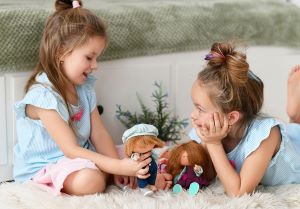May 18, 2021
by Patricia Tomasi
 A new study published in the Journal of Body Image looked at the effect playing with ultra-thin dolls has on the way young girls view their own bodies.
A new study published in the Journal of Body Image looked at the effect playing with ultra-thin dolls has on the way young girls view their own bodies.
“We were interested in understanding whether doll play would influence girls’ developing sense of an ‘ideal’ body,” study author Lynda Boothroyd, a professor in the Department of Psychology at Durham University in the UK told us. “There are many studies suggesting that other representations of the female body in our culture can influence body ideals in teenagers and adults, and since dolls are a very popular toy amongst young girls, they were a potentially important source of cultural influence on body ideals.”
According to a report by the Park Nicollet Melrose Center, over 80 per cent of 10-year-olds are scared of being overweight. Over half of 13-year-old girls in the U.S. are unhappy with their bodies. Seventy-eight per cent of 17-year-olds are unhappy with their bodies. In middle school, 40 to 70 per cent of girls are not happy with two or more parts of their body.
In Boothroyd’s study, girls selected their ‘ideal’ body size on an interactive computer program by moving the mouse to change the figure’s body weight.
“They then played with ultra-thin or realistic childlike dolls, and then indicated their body ideals again,” Boothroyd told us. “In a second experiment, all girls played with the ultra- thin dolls and then played with the realistic dolls or toy cars afterwards.”
About 30 per cent of children and youth aged 10 to 14 are actively dieting. Over 45 per cent of children aged nine to 11 are ‘sometimes’ or ‘very often’ on diets and 50 per cent of adolescent girls are engaging in damaging weight control activities such as smoking, fasting, missing meals, taking laxatives, or throwing up. Girls who diet a lot are 12 times as likely to binge eat as girls who do not frequently diet.
“We hypothesized that ultra-thin dolls would cause girls in our study to prefer thinner bodies after play than they did before – and this hypothesis was supported,” Boothroyd told us. “We also hypothesized that ‘realistic’ childlike dolls might be able to counter the effects of ultra-thin dolls if played with in sequence. But this wasn’t the case – once girls’ body ideals had changed after playing with ultra-thin dolls, further play even with healthy weight dolls didn’t make any more difference.”
Approximately 80 per cent of women in the United States don’t like the way they look and over 30 per cent of men are not satisfied with their own body. More than half of U.S. adults are not happy with how much they currently weigh and 70 per cent of women considered to be in the normal weight range want to be thinner.
“We definitely need to do more work to understand how long-lasting these effects are, and to explore a wider range of dolls for girls, and also muscly toys and body satisfaction in boys,” Boothroyd told us. “One of the most important things parents can do to protect their daughter’s body image is to present positive body image themselves and avoid appearance-based language. This helps girls to internalize a more resilient sense of their own body image, and may help them resist media/other cultural impacts.”
About the Author
 Patricia Tomasi
Patricia Tomasi
Patricia Tomasi is a mom, maternal mental health advocate, journalist, and speaker. She writes regularly for the Huffington Post Canada, focusing primarily on maternal mental health after suffering from severe postpartum anxiety twice. You can find her Huffington Post biography here. Patricia is also a Patient Expert Advisor for the North American-based, Maternal Mental Health Research Collective and is the founder of the online peer support group - Facebook Postpartum Depression & Anxiety Support Group - with over 1500 members worldwide. Blog: www.patriciatomasiblog.wordpress.com
Email: tomasi.patricia@gmail.com